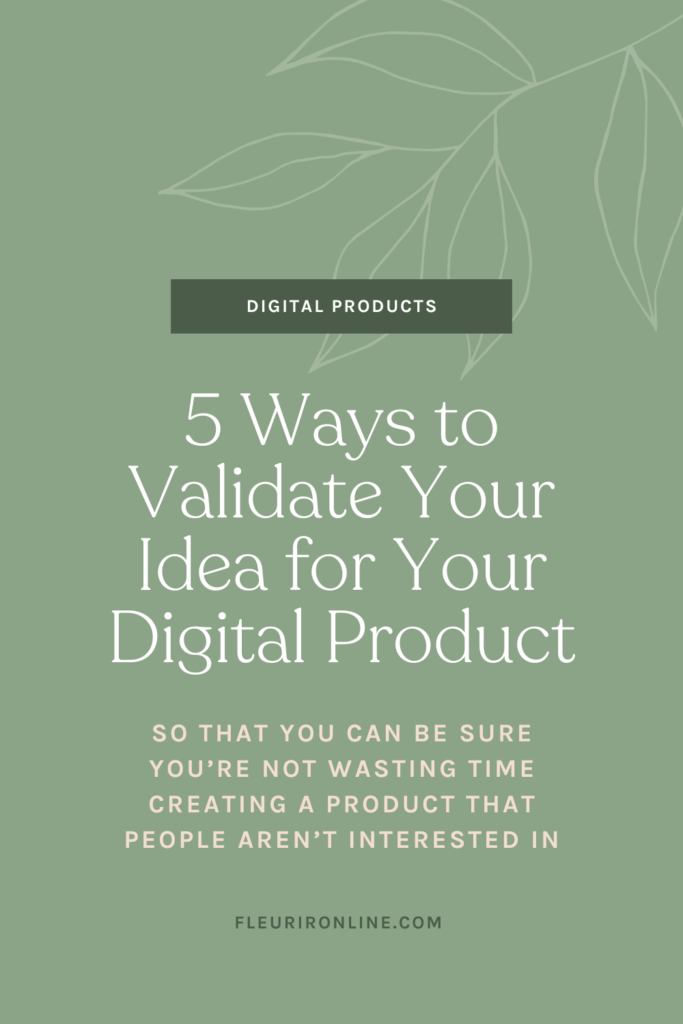This is the fifth in a series of 10 podcast episodes/blog posts all about digital products. Check out the other posts in this series below.
1. How to Create Digital Products That People Actually Want
2. 8 Digital Product Ideas for Your Service-Based Business
3. When is the Right Time to Create Digital Products?
4. How to Find the Time to Create Digital Products
5. 5 Ways to Validate Your Idea for Your Digital Product Idea
6. 5 Limiting Beliefs Keeping You From Creating Your Digital Product
7. The Tools You Need to Sell Digital Products
8. Digital Products vs Courses – Which Should You Create?
9. Your Digital Product Launch Questions Answered
10. Digital Products Not Selling? Here’s What to do
If you’re thinking about creating your first (or next) digital product but you’re asking yourself… How do I know this is something that they actually need? Or what if I create it and no one buys it? You’re going to want to listen to this episode.
In the first episode of this series, I spoke about how to create digital products that people actually want and the focus of that episode was market research.
Whilst market research is absolutely essential when creating anything new, you can also go a step further to ensure that you are creating a digital product that people are actually going to buy.
In this post, I’m sharing with you 5 ways that you can validate your idea for your digital product so that you can be sure you’re not wasting time creating a product that people aren’t interested in.
Now I want to caveat this by saying that as a service provider, you’ll likely already know the areas that your clients are needing support with whether that’s because you’ve had enquiries that haven’t converted because they are not quite ready for done-for-you services or perhaps you are frequently being asked for something that is going to help them with the next step after working with you.
If that’s the case then you will more than likely know what digital products to create. However, if you feel that you need further validation on your digital product idea, keep reading.

Listen to this episode
Listen to this episode and subscribe using your favourite podcast app!
Apple Podcasts | Spotify
1. Analyse demand through existing content
The first way in which you can validate your digital product idea is to analyse demand through your existing content.
Take a look at the stats behind your blog posts, podcast episodes, emails, social media posts and see what content is resonating with your audience the most. What content is getting the most engagement? What are your top-performing blog posts? Which emails are receiving the most open rates and click-throughs? What freebies are performing well?
In order to see this information, you’ll need to be able to access the stats so for blog posts and website traffic, a website analytics tool like Google Analytics is the place to look. For other more platform-based content such as social media and emails, take a look at the insights and reporting inside of the platforms themselves.
2. Build a waitlist
The second validation method you can use is the waitlist method. This method is one that I really love using in my own business and my clients have also seen great success with this method too.
The idea behind this method of validation is that you are beginning to build a list of people who are interested in your product.
All you need to build a waitlist is a landing page that gives enough information as to what your product is about and then a sign-up form with their name and email that is connected to your email marketing provider. They will then be added to a group or segment inside of your email marketing platform. It’s also a nice added touch to set up an automated email that thanks them for joining the waitlist and let’s them know what to expect.
It’s important to keep your waitlist engaged and not left in the dark with your launch so depending on how far out you begin to promote your waitlist, you will want to be sending them regular waitlist only emails as well as your regular emails that you send to your entire email list.
Typically you will offer your waitlist an exclusive bonus should they sign up during the waitlist launch period. This can be a discount, additional calls, extended access. Usually they also get the opportunity to apply or purchase before the main launch period so that if there are limited spots, they can secure their space.
3. Create a minimum viable product
The next way that you can validate your idea for your digital product is to create a minimum viable product. The idea behind creating a minimum viable product is that you create a much smaller product that provides enough features and information to meet a specific need. If the idea is validated at this level, you can then go on to build upon this when you create your larger product.
The MVP can be either a paid or free product for example, you could create a free 5-day email course that matches your overall product idea OR you could create a paid for mini-course that solves the first step in your framework.
4. Pre-sell your offer
The fourth option you have is to pre-sell your offer. As I mentioned earlier on, there is nothing worse than spending a whole lot of time creating a product that just doesn’t sell. Now there could be many reasons why your product isn’t selling and I’m actually going to be covering this in another episode in this series however, you don’t want to spend months working on something only for it to fall at the first hurdle. Especially when that time could be spent bringing revenue into the business in other ways.
Pre-selling your product means that you sell your product before you have created it. You may have heard of this as a beta product or beta launch. By selling your product first, you are not only validating that the idea is something that is needed, but you are also then being paid to create your product. Let’s say you have a course that you’re going to sell for $1000. If you pre-sell 10 spots on your course, you will be getting $10k before you’ve made it.
You can then go away and focus on creating the product knowing that the demand is there. When I mention this option to my clients, it sometimes takes them a while to come around to the idea. This is especially the case if you don’t work well under pressure. However, the upside to this is that you have a deadline to get it done. You no longer have time to sit on your idea and procrastinate because you have customers waiting for the product they have purchased. If you choose this option to validate your idea, I’d recommend being realistic with how long it will take to get the final product to them. For example, if it’s a course, will you be dripping modules every couple of weeks or can they expect to get the whole thing in two months’ time. Remember, you’re much better off underpromising and overdelivering than the other way around.
5. Check for similar products
One quick way to validate your product and understand your potential market is through competitor research. Do some research on your competitors and the products they have available. Whilst there are benefits to having a completely unique product, there are also benefits to having competition as well.
A common limiting belief that I hear often is that there are already too many similar products on the market so why should they buy mine? But it’s exactly that, a limiting belief. The way you should be looking at it is ‘okay great, there’s a market for this product. How can I develop something that is an improvement on what’s already out there?’
However, if you’ve taken a look at the market and you can’t see anything similar to what you want to produce then don’t panic just yet, this could be a good thing. It might just mean that no one has created it yet but there is still a need for it. You’ll just need to make sure you do your market research and turn to one of the other ways to validate your idea that I’ve mentioned in this episode.
So there you have it! 5 ways to help you validate your digital product idea so that you can feel confident in what you’re creating and safe in the knowledge that you are not wasting your time creating something that isn’t going to sell.
Now, you can use all of these methods or you can use just one or two of them. For example, you may do some research to check for similar products on the market and then take a look at the analytics for your own content. You then might decide to open up a waitlist and pre-sell to that waitlist or you could simply pre-sell by reaching out to your own personal list of people who you think would be a good fit for your product.
Be sure to check out the other posts in this series. Here’s a reminder of them again.
1. How to Create Digital Products That People Actually Want
2. 8 Digital Product Ideas for Your Service-Based Business
3. When is the Right Time to Create Digital Products?
4. How to Find the Time to Create Digital Products
5. 5 Ways to Validate Your Idea for Your Digital Product
6. 5 Limiting Beliefs Keeping You From Creating Your Digital Product
7. The Tools You Need to Sell Digital Products
8. Digital Products vs Courses – Which Should You Create?
9. Your Digital Product Launch Questions Answered
10. Digital Products Not Selling? Here’s What to do
If you’re looking for support, accountability and guidance in building digital products into your business, be sure to check out Expand Your Brand, my 12-month high-touch group program for online service providers who want to grow their audience, launch their digital product and make consistent sales.




